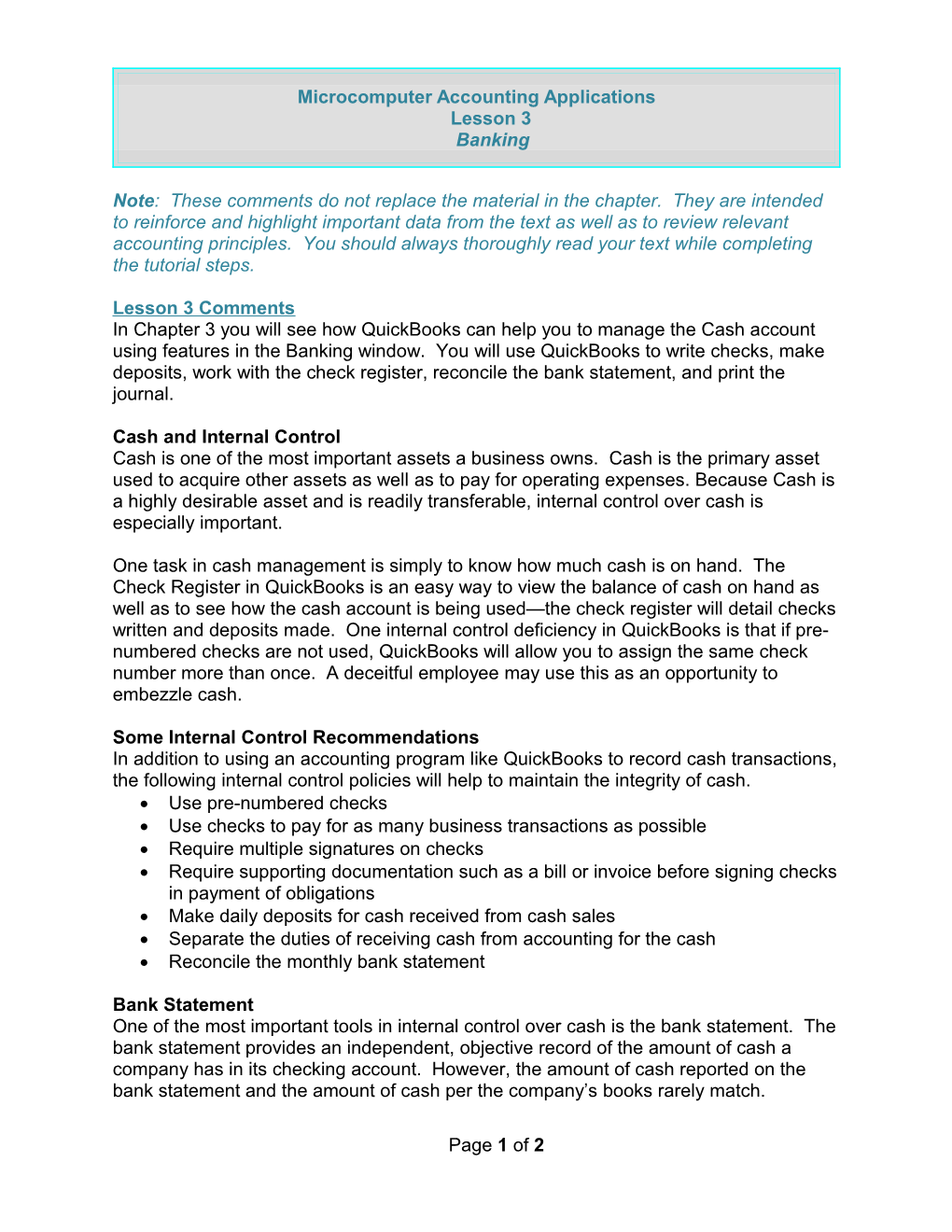Microcomputer Accounting ApplicationsLesson 3 Banking
Note: These comments do not replace the material in the chapter. They are intended to reinforce and highlight important data from the text as well as to review relevant accounting principles. You should always thoroughly read your text while completing the tutorial steps.
Lesson 3 Comments
In Chapter 3 you will see how QuickBooks can help you to manage the Cash account using features in the Banking window. You will use QuickBooks to write checks, make deposits, work with the check register, reconcile the bank statement, and print the journal.
Cash and Internal Control
Cash is one of the most important assets a business owns. Cash is the primary asset used to acquire other assets as well as to pay for operating expenses. Because Cash is a highly desirable asset and is readily transferable, internal control over cash is especially important.
One task in cash management is simply to know how much cash is on hand. The Check Register in QuickBooks is an easy way to view the balance of cash on hand as well as to see how the cash account is being used—the check register will detail checks written and deposits made. One internal control deficiency in QuickBooks is that if pre-numbered checks are not used, QuickBooks will allow you to assign the same check number more than once. A deceitful employee may use this as an opportunity to embezzle cash.
Some Internal Control Recommendations
In addition to using an accounting program like QuickBooks to record cash transactions, the following internal control policies will help to maintain the integrity of cash.
· Use pre-numbered checks
· Use checks to pay for as many business transactions as possible
· Require multiple signatures on checks
· Require supporting documentation such as a bill or invoice before signing checks in payment of obligations
· Make daily deposits for cash received from cash sales
· Separate the duties of receiving cash from accounting for the cash
· Reconcile the monthly bank statement
Bank Statement
One of the most important tools in internal control over cash is the bank statement. The bank statement provides an independent, objective record of the amount of cash a company has in its checking account. However, the amount of cash reported on the bank statement and the amount of cash per the company’s books rarely match.
Lesson 3 Comments (continued)
Some Common Reasons For Discrepancies Between The Books and the Bank Statement
· Outstanding Checks
· Deposits in Transit
· Interest Earned
· NSF Checks
· Bank Fees Charged
· Notes Collected by the Bank
· Errors
While QuickBooks provides a quick and easy way to reconcile your bank statement, including recording interest and fees, it is important for you to understand the steps involved in this process.
Check Register
The check register is a quick and easy way to view checks written and deposits made. While working with the check register, you will learn to void checks. QuickBooks will also allow you to simply delete a check written in error. While this method is simple, it is not good internal control. All checks should be pre-numbered and every number should be accounted for. Therefore, instead of deleting an erroneous check, you should VOID the check. Note that QuickBooks will show the voided check as CLEARED, but the memo line will show Void and the amount will be -0-.
Journal
As part of this lesson, you will also review the journal. As you write checks and make deposits in QuickBooks, a traditional journal entry is created for each of these transactions. To use QB, you need never look at the journal; however, as accounting professionals, you should view the journal and understand the affect of each transaction. See page 3.18 of your QuickBooks text for a review of the effect of debits and credits on each account type.
The normal balance of Cash is debit. Recall from Principles of Accounting that “normal balance” indicates the increase side for an account. Therefore, Cash increases with debits and decreases with credits. Each time you make a deposit in the Check Register in QuickBooks, an underlying journal entry is created debiting (increasing) Cash (note that QuickBooks generally assigns the checking account name to the Cash account). A credit is recorded to the account from which cash is received. Each time you write a check in QuickBooks, a journal entry is recorded crediting cash and debiting the account to which the cash is applied. For example, if a check was recorded in QuickBooks to pay the monthly rent of $1,200, an entry in the QuickBooks journal would contain the following transaction (shown in the format used in Principles of Accounting):
GENERAL JOURNALACCOUNT / DEBIT / CREDIT
Rent Expense / 1200 / 00
Cash / 1200 / 00
Page 1 of 2
